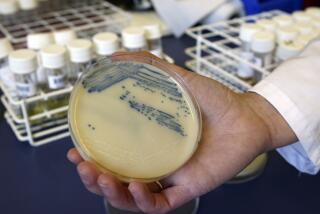An antibiotic wake-up call
On the growing roster of antibiotic-resistant diseases, gonorrhea is the one that has most recently captured the attention of public health officials. Writing in the New England Journal of Medicine, researchers at the U.S. Centers for Disease Control and Prevention warned last week that 1.7% of certain types of gonorrhea infections show little response to treatment, even with cephalosporins, the last line of antibiotic defense.
That might not sound like a lot, but with 600,000 Americans diagnosed annually, resistant cases number about 10,000 a year, and that number has been rising fast. Resistant gonorrhea is 17 times more common than it was just six years ago.
In January the U.S. Food and Drug Administration restricted the routine use of cephalosporins in livestock to preserve the drugs’ usefulness against diseases that plague people. Agricultural use isn’t necessarily related to resistant gonorrhea, a “wily” disease, as the CDC researchers put it, with a history of quickly outwitting available antibiotics. But the growing difficulty in curing one type of gonorrhea serves as a reminder that this nation must move far more aggressively to limit antibiotic use to the actual treatment of disease rather than to fatten livestock and prevent infections from sweeping through crowded animal pens.
At this point, no matter what happens with cephalosporins, resistant gonorrhea is on its way to winning out over available antibiotics, making it one of many worrisome bacterial strains, such as total-drug-resistant tuberculosis and MRSA, or methicillin-resistant Staphylococcus aureus. Resistant infections are emerging faster than new antibiotics. According to the nonprofit Pew Health Group, from 1935 to 1968, 13 classes of antibiotics were created; since 1968, there have been only two. Antibiotics are hard to develop and the profit margin on them is low because, unlike antidepressants or medications for high blood pressure, they’re not usually taken on a long-term basis.
Bills were introduced last year in both the House and Senate to encourage more pharmaceutical company research on antibiotics. They would extend patent protection for new antibiotics by five years and streamline FDA approval.
Such changes would be welcome, but many experts feel they don’t go far enough to encourage participation by large pharmaceutical companies. Congress should consider additional remedies, such as extending the FDA’s Orphan Drug program — which provides grants and other financial incentives for research on medications to treat rare diseases — to include antibiotics and redirecting National Institutes of Health funding from lower-priority projects to academic research. A multipronged effort by industry, universities and government, much like the effort that made AIDS a treatable disease, is needed to combat this looming health threat.
More to Read
A cure for the common opinion
Get thought-provoking perspectives with our weekly newsletter.
You may occasionally receive promotional content from the Los Angeles Times.










